Garden soil
by
Sara Stein
| 
|
But I realize now that to help one's garden overmuch is to hinder it. I must have been living in another world when I wrote, only a few years ago and with considerable satisfaction, of the view from my window of our gardens "bare to their bones, neat and clean, nicely edged, weed-free."
Now I see that there is teeming life down there that, neatly and cleanly, I was starving.
Why was I not replacing in their beds the limp bodies of weeds I had uprooted? What was I doing cutting flowers to the ground, raking them away, bagging grass clippings, blowing autumn leaves from underneath the hedge?
I was robbing the life savings from my garden beds, exposing them to the elements to leach their lifeblood away.
~ Sara Stein, from Noah's Garden: Restoring the Ecology of Our Own Back Yards, pp. 134-135
|
| Vanishing of the Bees movie |
 | | A honeybee getting nectar from winterberry flowers |
|
The Syracuse Chapter of the Holistic Moms Network, Syracuse Grows, and Slow Food CNY are holding a screening of the documentary "Vanishing of the Bees," an investigation of the economic, political, and ecological implications of the global disappearance of the honeybee.
WHEN: Fri. June 17 at 7pm
WHERE: ArtRage at 505 Hawley Avenue Syracuse
Suggested donation: $5
Local beekeepers will lead a discussion and answer questions following the screening and light snacks will be provided.
Seating is limited at 75 - first come, first serve.
|
| Preserving and Restoring Natural Landscapes Workshop |
 | | Cranberry bush viburnum (Viburnum trilobum) |
| |
Instructor: Jim Engel of White Oak Nursery
Date: Sat. July 9, 9-noon
Location: Linwood Gardens, 1912 York Road, Pavilion, NY
Deadline: July 6
Cost: $20, may pay upon arrival
To register, go to the Linwood Gardens website .
Jim will give a presentation on the identification of invasive plants, and strategies and methods of controlling invasive plants, as well as lead a discussion on the value of native versus non-native. There will be an opportunity for field identification.
|
| Interested in Edible Gardening? | 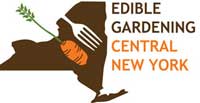
|
If you'd like to get information on Edible Gardening CNY, just send an email to John to find out about edible gardening tours and programs.
|
|
Join HGCNY!
|  |
Becoming an official member of HGCNY is easy: just join Wild Ones! When you're a Wild Ones member, you're automatically an official member of HGCNY. |
|
Greetings!
Time for Show Me, Help Me Tours
Summer is the time for our garden tours, which Wild Ones traditionally calls Show Me, Help Me tours. These aren't the kind of tours where you just admire beautiful gardens. These are tours where you learn from what the host has done and perhaps offer suggestions for any landscaping dilemmas they may have. Some of our tours have expert commentators, too. Our programs during the year are always interesting and informative, but there's nothing like seeing the results in people's yards!
Here are the dates scheduled so far:
Sunday July 17 at 3 pm in Canandaigua. This is a tour of a large woodland setting with trails and benches. Jim Engel will co-guide the tour. RSVP to Linda.
Saturday July 30 at 2 pm in Fulton. This is a tour of a village lot backing up to a marsh. You can bring boots if you'd like to go into the marsh. Dan Carroll will co-guide the tour. RSVP to Linda, the host.
Saturday August 27 in Jamesville
(Save the date. Details in upcoming newsletters.)
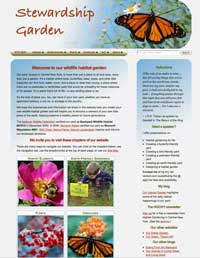 Meanwhile... Meanwhile...You can vicariously tour my own habitat garden by browsing through my website: OurHabitatGarden.org. You'll find lots of information about various creatures and how to provide habitat for them. Janet |
|
|
Are you robbing the life savings from your garden beds?
 | Newly weeded-out plants
composting in place
|
Weeding
As Sara Stein says (in the quote at left), you can "place in their beds the limp bodies of weeds" you have uprooted.
Here, I've left the plants right where they were growing, but it's easy to
 | | After just a few days |
tuck them behind some other plants so they'd be less noticeable.
After just a couple of days, the weeded-out plants are already less noticeable and on their way to enriching the soil.
Note: If you're weeding out undesirable plants with lots of seeds or potential seeds, such as dandelions (whose flowers can develop into seeds even after the plant is pulled out), you'll want to remove them from your garden altogether, perhaps by putting them in a black plastic bag or in a separate compost heap. This composting-in-place tip refers to weeding out extra plants, such as the excess jewelweed shown in the photos, before they're going to seed.
Fall
You can also leave fall leaves where they fall throughout the winter (except for lawn areas).
 | | Plants emerged through this garden debris left from last year |
Spring
You may leave many of the old dead leaves on the beds in the spring, although you might want to remove those covering delicate plants or young plants not yet established. Many or even most plants, though, will easily poke up through the leaves, just as they'd have to do in nature.
Or, if you prefer, even those leaves or other plant debris you remove can be composted in a more traditional fashion. The important thing is that the plant material on your property stays on your property, enriching it year after year.
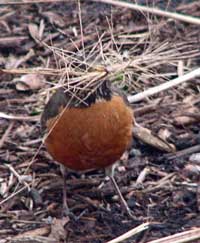 | | Robin gathering bits of old grass to use in building her nest |
Another reason
Another reason not to rake up and put all this garden "debris" out to the curb is that it represents building materials for wildlife.
|
|
Featured plant: Honeysuckles
Many people are more familiar with non-native rather than native honeysuckles. The non-native honeysuckles are invasive, but our native honeysuckles can be a beautiful addition to our yards.
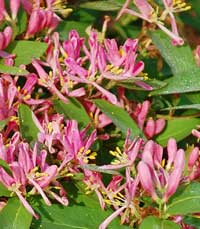 | | Non-native honeysuckle |
Non-native invasive honeysuckles
Even though non-native honeysuckles are invading our woodlands and beyond, they're still being sold. Don't be surprised to see these honeysuckles for sale at garden centers!
From the New York Invasive Species Clearinghouse:
Several species of honeysuckle found in NY are characterized as invasive, including:
Morrow's honeysuckle (Lonicera morrowii) Tatarian honeysuckle (L. tatarica)
Amur honeysuckle (L. maackii)
Japanese honeysuckle (L. japonica).
To the non-botanist, native and invasive non-native honeysuckles appear very similar. One way to distinguish between native and invasive honeysuckles is by looking at the stems - native honeysuckles have solid stems while invasive honeysuckles have hollow stems.
Native honeysuckles  | | Trumpet honeysuckle |
Trumpet honeysuckle (L. sempervirens) is a beautiful native honeysuckle vine. It blooms throughout the summer, has coral trumpet flowers, and has berries in the fall. Hummingbirds love it! It's fairly easy to find in garden centers.  | | Hairy honeysuckle |
Hairy honeysuckle (L. hirsuta) has buttery yellow flowers. Unlike trumpet honeysuckle, it blooms in one big display in June. Its leaves are hairy and quite attractive. Bees love it! It's more difficult to find this for sale. Perhaps you could request that they order it. |
|
This news stinks!
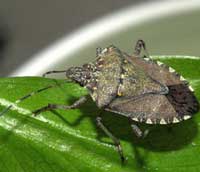 | |
Photo: CC Wikipedia from invasive.org
Brown marmorated stink bug |
Yet another non-native invader is poised to wreak havoc on our gardens and even inside our homes. It's the brown marmorated stink bug, an Asian species, that was first documented in Allentown PA in September 1998.
It has been spotted in NYS, too, but apparently not yet officially in Onondaga County. [Editor's note: I saw two stink bugs recently, but at the time I didn't know about this non-native variety, so I didn't check as to the type. I'm now on the lookout!]
There are native stink bugs, too, so don't mistakenly eliminate our native species. You can identify the non-native species by the white band on its antennae.
A humorous 5-minute YouTube video produced by Rutgers University and the Entomological Society of America describes the insect and gives some tips on keeping them out of your house, which focuses on mechanically excluding them, such as by caulking.
Directions for making your own stink bug trap are on YouTube.
A factsheet from the University of Maryland has a good summary of the bug, what it does, and what you can do about it if you find it in your yard or home. |
|
|
|
|